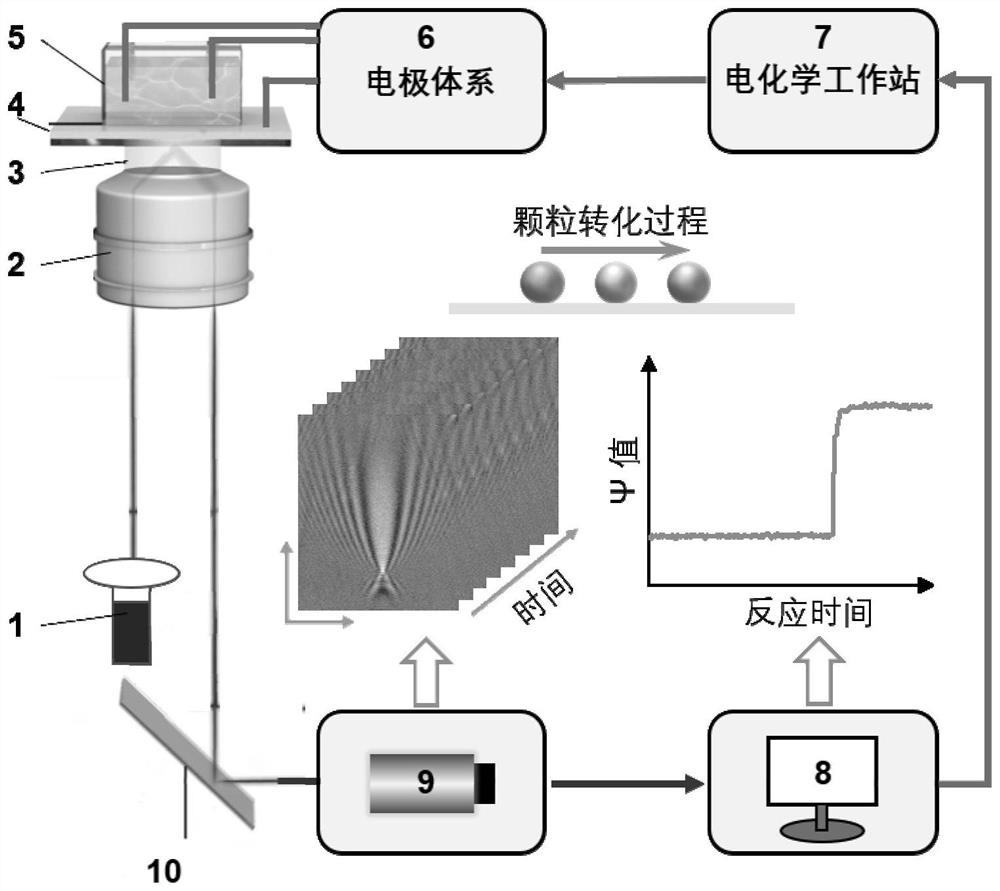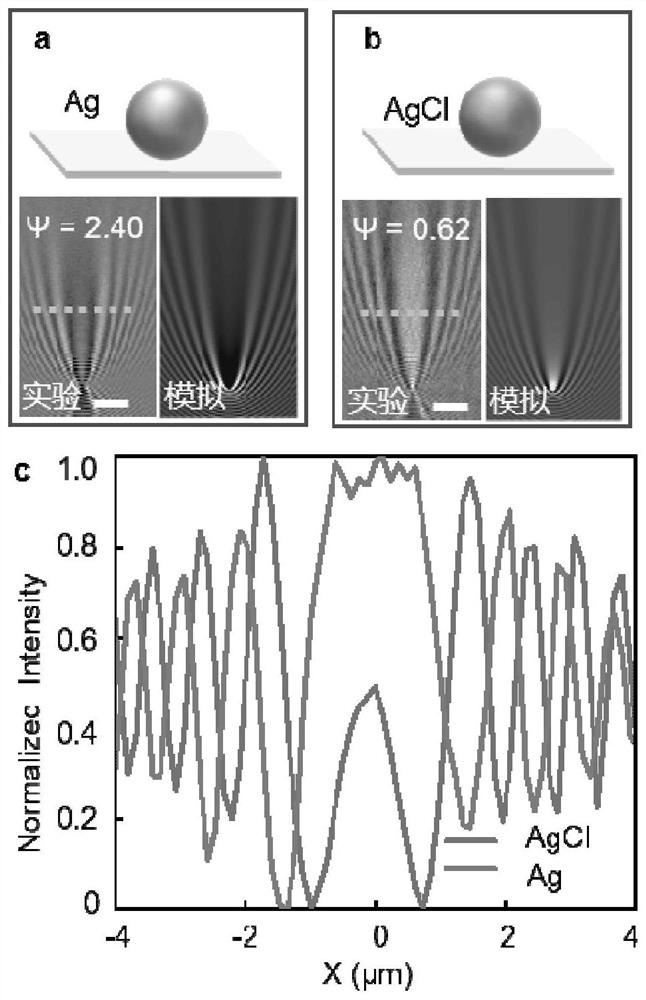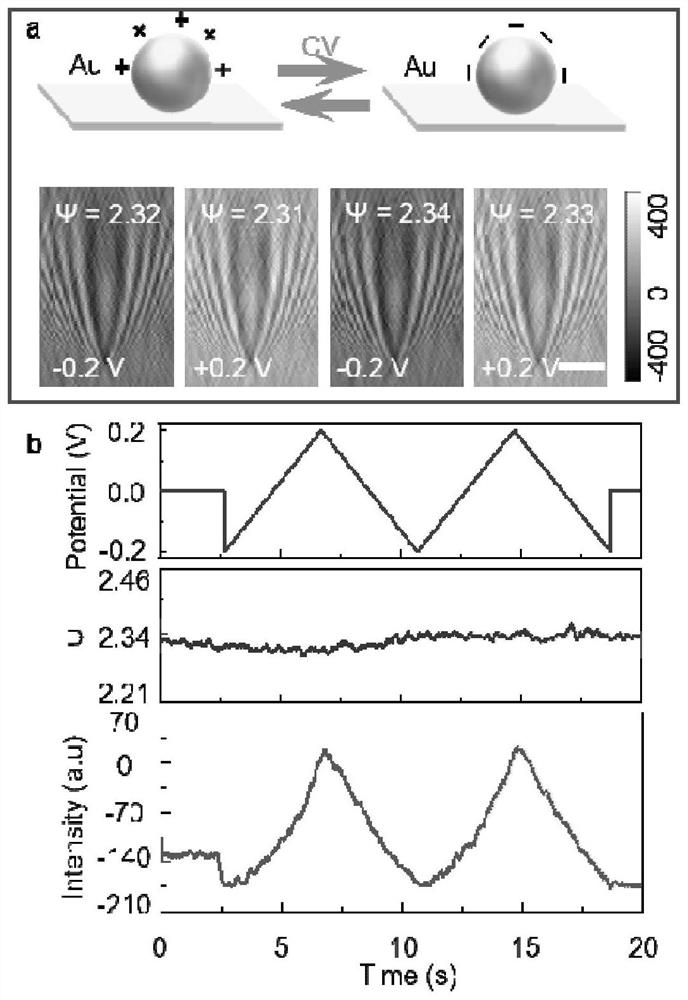Method for optical nondestructive detection of surface-interface conversion of single nanoparticles
A nanoparticle, surface interface technology, applied in the field of single nanoparticle imaging and analysis, can solve the problems that particle analysis cannot be applied in situ, the size of nanoparticles is small, and it is difficult to achieve high-throughput analysis of nanoparticles
- Summary
- Abstract
- Description
- Claims
- Application Information
AI Technical Summary
Problems solved by technology
Method used
Image
Examples
Embodiment 1
[0035] Build a single nanoparticle surface-interface conversion optical imaging system, the system structure is as follows: figure 1 shown, including:
[0036] Laser light source 1, objective lens 2, mirror oil 3, gold-coated glass sheet 4, sample cell 5, reaction condition control module including electrode system 6 and electrochemical workstation 7, software processing module 8, camera acquisition system 9, mirror 10.
[0037] The laser light source 1 is used to introduce monochromatic light of a fixed wavelength into the surface plasmon imaging and adjust the light intensity of the laser to meet the imaging requirements, and select a laser above 630nm as the excitation light source;
[0038] The objective lens 2 is used for optical signal amplification and imaging, and the immersion oil 3 is located between the optical microscopic magnifying objective lens and the gold film glass slide. The numerical aperture of the optical microscopic magnifying objective lens is greater t...
Embodiment 2
[0046] A method for optically non-destructively detecting the surface-interface transformation of a single nanoparticle, taking Ag and AgCl nanoparticles as an example, using the system built in Example 1, the detection method includes the steps:
[0047] (1) Synthesize target Ag and AgCl nanoparticles;
[0048] (2) Build a single-particle optical imaging device;
[0049] Add the solution containing the target particles into the reaction tank, collect time series images, and use the software processing module to analyze and obtain the characteristic phase parameter ψ of the nanoparticles as a function of time, so as to analyze the surface and interface transformation process of single nanoparticles.
[0050] Result analysis:
[0051] The experimental and simulation diagrams of the synthesized Ag nanoparticles are shown in figure 2 As shown in a, the diameter of Ag nanoparticles is 80nm. It can be seen from the imaging experiment diagram and theoretical simulation diagram th...
experiment example 1
[0055] In order to test the label-free optical imaging that the method of the present invention can effectively resist background current signal interference, take Au nanoparticles as an example to verify, and the specific determination steps include:
[0056] (1) Synthesis of target Au nanoparticles;
[0057] (2) Build the device;
[0058] Add a certain concentration of KCl solution into the electrochemical cell, drop the solution containing the target Au particles into the sample cell, set the electrochemical parameters through the software processing module 8, collect time series images, and use the software processing module 8 to obtain the characteristics of the Au particles The value of the phase parameter ψ, while reading the particle intensity value directly on the image sequence.
[0059] Result analysis:
[0060] see test results image 3 as shown, image 3 a, Au nanoparticles do not undergo any compositional conversion in this potential interval (+0.2 V, −0.2 V)...
PUM
| Property | Measurement | Unit |
|---|---|---|
| Diameter | aaaaa | aaaaa |
| Diameter | aaaaa | aaaaa |
Abstract
Description
Claims
Application Information
 Login to View More
Login to View More - R&D
- Intellectual Property
- Life Sciences
- Materials
- Tech Scout
- Unparalleled Data Quality
- Higher Quality Content
- 60% Fewer Hallucinations
Browse by: Latest US Patents, China's latest patents, Technical Efficacy Thesaurus, Application Domain, Technology Topic, Popular Technical Reports.
© 2025 PatSnap. All rights reserved.Legal|Privacy policy|Modern Slavery Act Transparency Statement|Sitemap|About US| Contact US: help@patsnap.com



